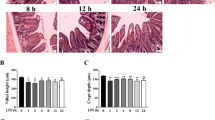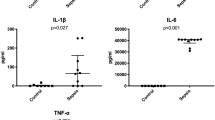Abstract
The present study aimed to determine whether any specific intestinal site or intestinal mucosal inflammation is highly correlated with bacterial translocation (BT). Enterostomy tubes were surgically placed in adult male Sprague–Dawley rats 5 days before induction of experimental model. After surgery, sterile water containing kanamycin (25 mg/L) was injected into each intestinal segment through the tubes for 3 days. Green fluorescent protein (GFP)-transfected Escherichia coli (n = 30 for lipopolysaccharide (LPS) group, and n = 30 for control group) or 0.9 % saline (n = 30 for blank group) were injected into each intestinal segment through the tubes for two consecutive days. Rats were then subjected to LPS-induced endotoxemia; lactulose and mannitol were injected into each intestinal segment through the tubes simultaneously. At 6 h after LPS injection, BT to distant organs and integrity of tight junctions (TJ) were examined by fluorescence and electron microscopy, respectively. The urinary excretion ratio of lactulose/mannitol (L/M) and intestinal mucosal cytokine levels were assessed. We found that the intestinal permeability, reflected by translocation rates of GFP-labeled E. coli, the levels of open TJ, the excretion ratio of L/M, and the inflammatory cytokine levels were higher in the LPS group than in the control and blank groups. The endotoxemia ileum showed the highest levels of both intestinal permeability and inflammatory cytokine, while the colon showed the lowest. The present study of endotoxemia rats suggests that LPS increases gut paracellular permeability and induces BT. The ileum is the site of greatest BT risk, while the colon is the lowest, and the difference in risk between these sites is correlated with intestinal mucosal inflammation.






Similar content being viewed by others
REFERENCES
Puleo, F., et al. 2011. Gut failure in the ICU. Seminars in Respiratory and Critical Care Medicine 32: 626–638.
Dowdall, J.F., et al. 2002. Inosine modulates gut barrier dysfunction and end organ damage in a model of ischemia-reperfusion injury. Journal of Surgical Research 108: 61–68.
Zhang, W., et al. 2010. Intestinal flora imbalance results in altered bacterial translocation and liver function in rats with experimental cirrhosis. European Journal of Gastroenterology and Hepatology 22: 1481–1486.
Balzan, S., et al. 2007. Bacterial translocation: overview of mechanisms and clinical impact. Journal of Gastroenterology and Hepatology 22: 464–471.
Garrett, R.E., et al. 2008. Constipation critical illness and mortality: gut-derived toxidromes-real and now imagined. Critical Care Medicine 36: 2710–2711.
Buttenschoen, K., et al. 2010. Endotoxin elimination in sepsis: physiology and therapeutic application. Langenbeck's Archives of Surgery 395: 597–605.
Velasco, N. 2006. Gut barrier in the critically ill patient: facts and trends. Revista Médica de Chile 134: 1033–1039.
Reiner, W., et al. 2003. Bacterial translocation in the gut. Best Practice & Research. Clinical Gastroenterology 17: 397–425.
Turner, J.R. 2000. ‘Putting the squeeze’ on the tight junction: understanding cytoskeletal regulation. Seminars in Cell & Developmental Biology 11: 301–308.
Nusrat, A., et al. 2000. Molecular physiology and pathophysiology of tight junctions. IV. Regulation of tight junctions by extracellular stimuli: nutrients, cytokines, and immune cells. American Journal of Physiology 279: G851–7.
Wainwright, M.S., et al. 2003. Protein kinase involved in lung injury susceptibility: evidence from enzyme isoform genetic knockout and in vivo inhibitor treatment. Proceedings of the National Academy of Sciences of the United States of America 100: 6233–6236.
Martin, G.S., et al. 2003. The epidemiology of sepsis in the United States from 1979 through 2000. The New England Journal of Medicine 348: 1546–1554.
Bruewer, M., et al. 2003. Proinflammatory cytokines disrupt epithelial barrier function by apoptosis-independent mechanisms. Journal of Immunology 171: 6164–6172.
Tazuke, Y., et al. 2003. Interleukin-6 changes tight junction permeability and intracellular phospholipid content in a human enterocyte cell culture model. Pediatric Surgery International 19: 321–325.
Samel, S., et al. 2006. Microscopy of bacterial translocation during small bowel obstruction and ischemia in vivo—a new animal model. BMC Surgery 2: 6.
Soderholm, J.D., et al. 2002. Augmented increase in tight junction permeability by luminal stimuli in the non-inflamed ileum of Crohn’s disease. Gut 50: 307–313.
Berg, R.D., and A.W. Garlington. 1979. Translocation of certain indigenous bacteria from the gastrointestinal tract to the mesentericlymph nodes and other organs in a gnotobiotic mouse model. Infection and Immunity 23: 403–411.
Wu, J., et al. 2010. Bifidobacterium adolescentis supplementation ameliorates parenteral nutrition-induced liver injury in infant rabbits. Digestive Diseases and Sciences 55: 2814–2820.
Simsek, I., et al. 2001. Inhibition of inducible nitric oxide synthase reduces bacterial translocation in a rat model of acute pancreatitis. Pancreas 23: 296–301.
Ding, W., et al. 2011. Comparisons of three surgical procedures on intestine ischemia reperfusion injury in a superior mesenteric artery injury model. Journal of Surgical Research 168: 119–126.
Generoso, S.V., et al. 2011. Protection against increased intestinal permeability and bacterial translocation induced by intestinal obstruction in mice treated with viable and heat-killed Saccharomyces boulardii. European Journal of Nutrition 50: 261–269.
Porras, M., et al. 2004. Intestinal motor disorders associated with cyclical bacterial overgrowth in a rat model of enteritis. American Journal of Physiology - Gastrointestinal and Liver Physiology 287: G58–64.
Eaves-Pyles, T., et al. 2000. Sodium arsenite induces the stress response in the gut and decreases bacterial translocation in a burned mouse model with gut-derived sepsis. Shock 13: 314–319.
Berg, R.D., et al. 1988. Immunosuppression and intestinal bacterial overgrowth synergistically promote bacterial translocation. Archives of Surgery 123: 1359–1364.
Chalfie, M., et al. 1994. Green fluorescent protein as a marker for gene expression. Science 263: 802–805.
Elliott, D., et al. 2000. Endotoxin-induced ileal mucosal injury and nitric oxide dysregulation are temporally dissociated. American Journal of Respiratory and Critical Care Medicine 161: 1705–1712.
Debets, J.R., and R. Kampmeijer. 1989. Plasma tumor necrosis factor and mortality in critically ill septic patients. Critical Care Medicine 17(6): 489–494.
Leonidou, L. 2007. Cytokine production and hospital mortality in patients with sepsis-induced stress hyperglycemia. Journal of Infection 55(4): 340–346.
Berg, R.D. 1999. Bacterial translocation from the gastrointestinal tract. Advances in Experimental Medicine and Biology 473: 11–30.
Deitch, E.A., et al. 1989. Endotoxin induces bacterial translocation and increases xanthine oxidase activity. The Journal of Trauma 29: 1679–1683.
Mosenthal, A.C., et al. 2002. Elemental and intravenous total parenteral nutrition diet-induced gut barrier failure is intestinal site specific and can be prevented by feeding nonfermentable fiber. Critical Care Medicine 30: 396–402.
Fukushima, R., et al. 1994. The primary site of bacterial translocation. Archives of Surgery 129: 53–58.
Powell, D.W. 1981. Barrier function of epithelia. American Journal of Physiology 241: G275–288.
Deitch, E.A., et al. 1990. Endotoxin-induced bacterial translocation and mucosal permeability: role of xanthine oxidase, complement activation, and macrophage products. Critical Care Medicine 19: 785–791.
Morin, M.J., et al. 1998. Differential expression of inducible nitric oxide synthase messenger RNA along the longitudinal and crypt–villus axes of the intestine in endotoxemic rats. Critical Care Medicine 26: 1258–1264.
ACKNOWLEDGMENTS
This work was supported by grants from the National Nature Science Foundation of China (30830098).
Author information
Authors and Affiliations
Corresponding author
Rights and permissions
About this article
Cite this article
Yue, C., Ma, B., Zhao, Y. et al. Lipopolysaccharide-Induced Bacterial Translocation Is Intestine Site-Specific and Associates with Intestinal Mucosal Inflammation. Inflammation 35, 1880–1888 (2012). https://doi.org/10.1007/s10753-012-9510-1
Published:
Issue Date:
DOI: https://doi.org/10.1007/s10753-012-9510-1




